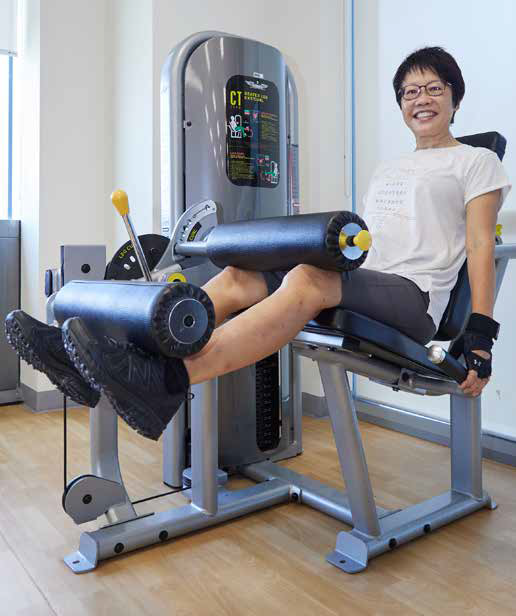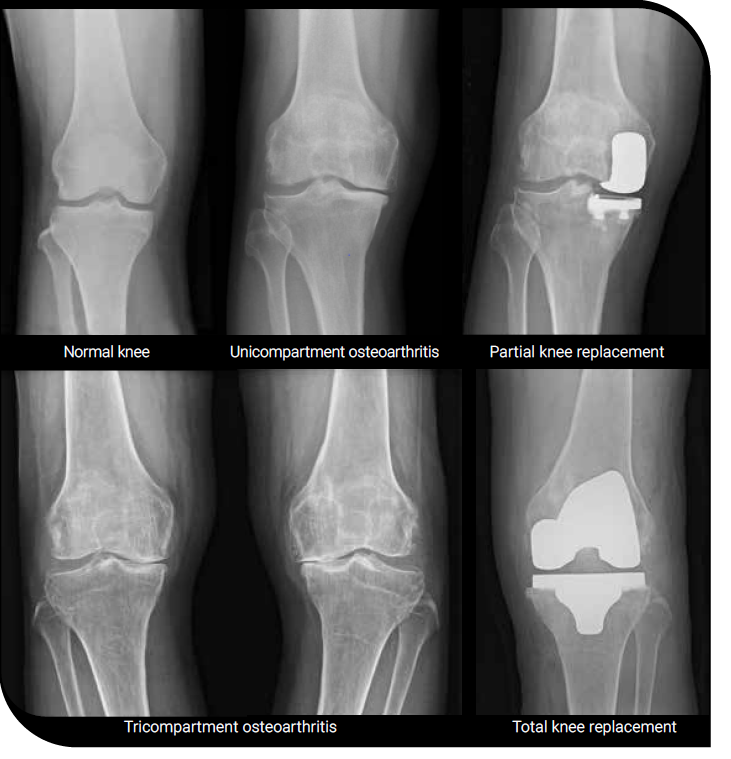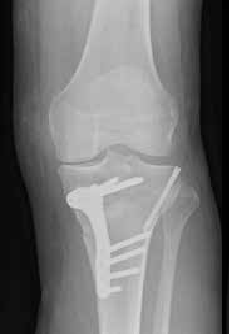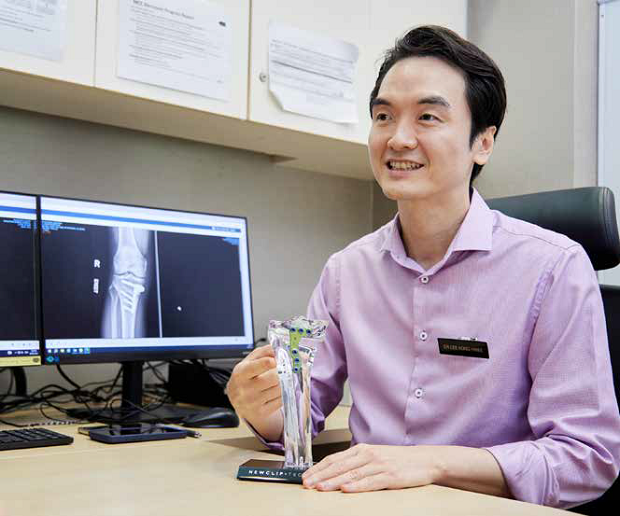Not all bad knees need a total replacement of the joint. It is only when joint damage is very severe or complex that a total knee replacement (TKR) is likely. Otherwise, partial knee replacement (PKR) or knee preservation (KP) are options for those whose knees are less damaged.
Knee pain can be due to diseases like gout and rheumatoid arthritis, but is most often due to osteoarthritis (OA), where the protective cartilage that cushions the joints is worn down over time. OA is a significant health concern due to its impact on mobility and quality of life. Typically a disease of the elderly, OA is increasingly affecting younger patients amid a rise in popularity of vigorous sporting activities.
“Some patients wonder if their x-rays show enough damage to warrant a knee replacement. However, not everyone with these changes needs surgery. We only consider surgery if the arthritis is causing significant problems and other treatments like medication, physical therapy, or exercises haven’t helped,” said Dr Eric Liu, Consultant, Department of Orthopaedic Surgery, Singapore General Hospital (SGH).
In a healthy knee joint, cartilage and the gelatinous meniscus separate the femur (thigh bone) and tibia (shin bone). With wear and tear, the two layers are worn away. Walking and other movements cause the femur and tibia to rub against each other, causing pain and inflammation. “The main aim of knee replacement is to reduce pain and improve function. It’s important to understand that as we age, x-rays often show signs of wear and tear,” Dr Liu said.
In a joint replacement surgery, or joint arthroplasty, the entire joint is not removed and replaced — just the damaged cartilage surrounding the joint, which is then covered with a metal surface. The femur and tibia are also preserved as much as possible. “It’s much like fixing a cavity in a tooth. The dentist removes the decay and fills it with metal or another material. We’re doing something similar but on a larger scale with the knee. A more accurate term would be ‘knee joint resurfacing surgery,’ but we still use the old name — ‘replacement’ — out of habit,” said Dr Liu.

<<Ms Diana Chin was diagnosed with medial compartment osteoarthritis. In her early 60s, she underwent proximal fibular osteotomy, a method of knee preservation. Ms Chin, whose scar is barely visible, was able to walk the next day with the aid of crutches, and resumed her active lifestyle soon after.>>
Total knee replacement
TKR, also known as total knee arthroplasty, is a surgical procedure to replace the damaged or diseased knee joint with an artificial implant. It involves removing damaged bone and cartilage from the knee joint and replacing them with metal and plastic components that mimic the natural knee joint.
TKR is typically recommended for patients with OA affecting the entire knee joint, significant deformity, or extensive damage to the three areas, or compartments, of the knee. It may also be recommended for patients with inflammatory arthritis, post-traumatic arthritis, or other conditions causing severe knee pain and functional impairment.
The success rates for TKR are generally high, but outcomes depend on patients’ age, overall health, severity of the arthritis, and rehabilitation compliance, said Dr Liu. “TKR implants are designed to last for many years, with the majority lasting 20 years or more,” he said.
TKR can significantly improve knee pain, function and mobility, and quality of life for many patients, while risks include infection, blood clots, implant loosening, stiffness, and nerve damage.
SGH performs more than 3,000 TKR surgeries each year, about half the 6,000 done every year in Singapore, Dr Liu said. TKR is performed as a day surgery at SGH for most patients.
Partial knee replacement
In PKR, or unicompartmental knee arthroplasty, only the damaged portion of the knee joint is replaced with a prosthetic implant made of metal and plastic to restore the natural knee anatomy.
This procedure is typically recommended for younger patients and those with isolated unicompartmental knee osteoarthritis, where only one part of the knee is affected, usually the medial, or inner, compartment. “PKR can provide excellent pain relief and functional improvement for suitable candidates. Success rates are generally high, but long-term outcomes may be influenced by factors such as patient selection and implant longevity,” said Dr Liu.
As with TKR implants, PKR implants can last years — about 10 years for 80 per cent of patients. Longevity, though, may be influenced by factors such as the patient’s age and activity level, and the design of the implant.
With smaller incisions, PKR patients recover faster than TKR patients, and are able to return to normal activities about a month after surgery. They have improved joint function and a lower risk of infection, but have a greater risk of fracture during surgery. Should they need a TKR at a later time, conversion surgery is slightly more difficult than TKR on a native joint.
About 200 PKR procedures are performed yearly at SGH, far fewer than TKR surgeries.

<<(Top, from
left) X-ray
images show
a normal knee;
unicompartment
OA with some
wearing on inner
side of knee; and
post-partial knee
replacement. (Above,
from left)
Tricompartment
OA with severe
damage to
both knees; and
post-total knee
replacement.>>
<<(Below)
Post-knee
preservation
surgery realigns
the knee to take
pressure off
the damaged
portion of the
knee joint.>>

Knee preservation
As its name suggests, this procedure preserves the patient’s own knee by realigning the shin or thigh bone to reduce the load on the damaged part of the joint, thus providing relief for patients with significant knee problems. KP is suitable for individuals who are under 60 years of age with moderate knee OA and a strong preference in maintaining an active lifestyle.

According to Dr Lee Kong Hwee (above), Senior Consultant, Department of Orthopaedic Surgery, SGH, knee implants used in PKR or TKR may not be an ideal solution for younger patients as they may need another implant later on in life. KP surgery, however, not only addresses their knee OA problem, but may also help patients delay or even avoid the need for a knee replacement surgery in the future. “Should the arthritis advance for whatever reason, the patient can still go for a replacement; that bridge is not burnt,” said Dr Lee, who is also Director, Sports Service, and spearheads SGH’s Knee Preservation Service, set up in 2019.
Data show that 80 per cent of patients who underwent a type of preservation surgery known as high tibial osteotomy (HTO) did not need a knee replacement for at least 10 years after the surgery. In HTO, the surgeon creates a wedgeshaped opening in the upper portion of the shin bone via a small 4cm incision. A bone graft wedge is then inserted into the opening and secured in place with a titanium plate and screws to realign the knee and to take pressure off the damaged portion of the knee joint.
Besides HTO, proximal fibular osteotomy (PFO) is another KP procedure commonly performed at SGH for patients who suffer from medial compartment OA. With medial knee OA, patients only feel pain in the inner part of the knee because the cartilage that covers the ends of the femur and tibia has been worn out. Thus, the bones rub against each other at the joint, causing the pain. PFO is a simple procedure that does not require implants, and is recommended for patients who have severe skin dermatitis, poorly controlled diabetes, or poor immunity. In PFO, 2cm of the patient’s fibula is removed to disconnect the support to the outer part of the knee, allowing for a more balanced distribution of weight across the entire knee joint, alleviating pain in the process. Patients are able to walk on the same day of surgery, and have minimal down-time.
At SGH, KP procedures are gaining popularity. Since the methods were first offered as viable treatment options in 1999 and 2000, 400 KP procedures have been done by end of 2023, compared to 50 at end-2000.
Get the latest updates about Singapore Health in your mailbox! Click here to subscribe.
